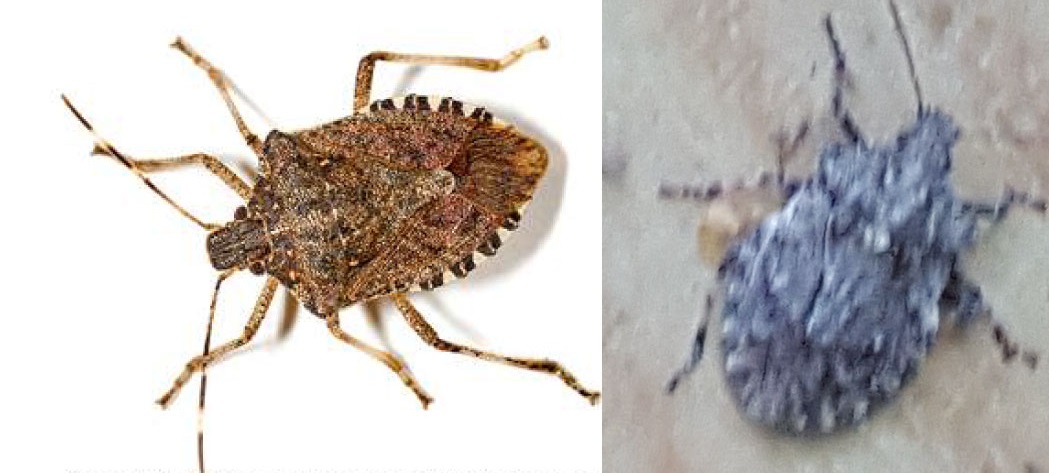SCORES & OUTDOORS: Two different stink bugs; one good, one not so good
 by Roland D. Hallee
by Roland D. Hallee
There it was. On the deck in front of the barbecue grill. I’d seen something similar before, but that one was brown. This one was a bluish color.
A little wracking of the brain produced no results. It was time to ask my contacts at the state level.
Allison Kanoti, acting state entomologist with the Maine Forest Service, told me it was a Rough Stink Bug, Brochymena arborea. That jogged my memory. What I had seen before, which looked exactly alike, instead of the color, was a Marmorated stink but, which I wrote about in the November 15, 2017, column. They are similar, but different.
The brown marmorated stink bug is an invasive species and considered a serious crop pest. They were accidentally introduced in the United States from Asia. It is believed to have hitched a ride as a stow-away in packing crates or on various types of machinery, first appearing in Allentown, Pennsylvania, in 1996. Following its arrival, the brown marmorated stink bug spread quickly from state to state, and is now listed as a top invasive special of interest by the U.S. Department of Agriculture (USDA) since 2013. It is readily found in the eastern half of the U.S., as well as several western and southwestern states.
At first glance, the two stink bugs are easily confused. If you find large numbers of stink bugs in or around your residence, chances are it is the invader, not our natives.
So, how do you go about telling them apart. First, look at their antennae. The brown marmorated stink bug has white bands on the last two antennal segments. Rough stink bugs have no such contrasting markings on the antennae. Second, look at the leading edge of the top of the thorax, right behind the head. There are fine teeth along that edge in the rough stink bug, so it is not the brown marmorated.
Again, they are called stink bugs because they produce teeming amounts of foul-smelling fluid that is discharged if disturbed.
Rough stink bugs are very well camouflaged and closely resemble the color and texture of tree bark on which it lives.
The rough stink bugs are beneficial insects that control caterpillars and other insect pests. Before randomly destroying an insect, always attempt to identify it first, or at least determine whether it’s a beneficial or pest. No one wants to kill a perfectly good bug. However, since little is known about these insects of non-economic importance, they are suspected of feeding on the sap of host trees and shrubs Though there are persistent rumors they are occasionally predatory, and many true bugs are opportunistic predators or scavengers on other insects, this may not be a stretch.
Eggs are laid in small clusters, resembling a honeycomb, on twigs of trees, and the nymphs that hatch progress through four instars (an instar is the interval between molts) before reaching adulthood. Their development from egg to adult is surprisingly long, so there is but one generation produced annually.
Rough stink bugs have an ability to withstand the cold. BugEric, Eric R. Eaton, an expert in the field, said he once attempted to kill rough stink bugs by putting them in a container in the freezer. He thinks he left them there for about a week or so. When he took them, he found them coming back to life in a relatively short period of time.
Rough stink bugs are the prey of the sand wasp. The female stings the stink but into paralysis, and then flies it back to her nest burrow where she deposits it as food for her larval offspring. Birds are also recorded as predators of the stink bugs. It amazes me that any other creature could find them and make a meal out of them, but they do have enemies.
You can look for the rough stink bugs in spring and fall when they are emerging from, and entering, hibernation. You’ll have to look closely, though, given their camouflage.
I don’t know what that rough stink bug was doing that day on my deck, in broad daylight, but it is contrary of what is known about them, that they camouflage well, and are difficult to find because they are fewer in number than the brown marmorated stink bug. I just got lucky, I guess.
Roland’s trivia question of the week:
The Red Sox ownership ventured in NASCAR racing in 2007. What was the name of the race team?
Responsible journalism is hard work!
It is also expensive!
If you enjoy reading The Town Line and the good news we bring you each week, would you consider a donation to help us continue the work we’re doing?
The Town Line is a 501(c)(3) nonprofit private foundation, and all donations are tax deductible under the Internal Revenue Service code.
To help, please visit our online donation page or mail a check payable to The Town Line, PO Box 89, South China, ME 04358. Your contribution is appreciated!



Leave a Reply
Want to join the discussion?Feel free to contribute!